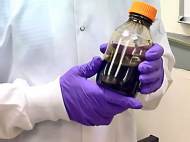Yale engineers developed a magnetic fluid pump with no moving parts
 A group of researchers from Yale University and colleagues from the University of Georgia and Massachusetts Institute of Technology demonstrated a novel approach that allows ferrofluids to be pumped by magnetic fields alone. The approach could allow this material to be used in new generation of highly compact, integrated, quiet, and efficient liquid cooling schemes for portable, high-performance consumer electronics.
A group of researchers from Yale University and colleagues from the University of Georgia and Massachusetts Institute of Technology demonstrated a novel approach that allows ferrofluids to be pumped by magnetic fields alone. The approach could allow this material to be used in new generation of highly compact, integrated, quiet, and efficient liquid cooling schemes for portable, high-performance consumer electronics.
Developed in the 1960s by NASA scientists seeking a non-mechanical method for moving liquid fuels in outer space, ferrofluids are made up of magnetic nanoparticles suspended in liquids such as oil, water, or alcohol. Though numerous industrial, commercial, and biomedical applications for ferrofluids have been created since then, the original goal-to pump liquids with no machinery-remained elusive, until now.
“We have shown that ferrofluids may be pumped at controllable speeds in closed-loop geometries without any mechanically moving parts”, said Hur Koser, Associate Professor of Electrical Engineering at Yale. “We don’t rely on any other material; no magnets, nothing moving but the ferrofluid that we’re pumping.”
The ferrohydrodynamic pump method works when electrodes wound around a pipe force magnetic nanoparticles within the ferrofluids to rotate at varying speeds. The particles closest to the electrodes spin faster, and the resulting spatial variation in rotation speed propels the ferrofluid forward. Koser and colleagues demonstrated the simplicity of this “hands-free” pumping scheme using a stereo amplifier, ordinary plumbing materials from the local hardware store, and a commercially available mineral oil/magnetite ferrofluid that is easy to make and safe to handle.
Following on successful computational simulations, the so-called “ferrohydrodynamic pumping mechanism” that Koser and colleagues have now validated could be used in systems as tiny as microfluidic devices, or as large as industrial-scale pumps.
“Pumping systems can be much cheaper and easier to manufacture when liquid can be moved without machinery”, said Koser.
For instance, ferrofluid cooling would eliminate the need for fans and heat plumbing inside computers, enabling further miniaturization. It could also be used to cool computers more efficiently. Novel medical applications, such as cell sorting, might also be enabled by biocompatible ferrofluids.
For more information, read the article published in the Physical Review B named: “Direct observation of closed-loop ferrohydrodynamic pumping under traveling magnetic fields”.









You write so honestly about this. Thanks for sharing!